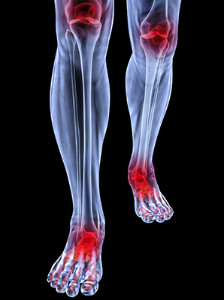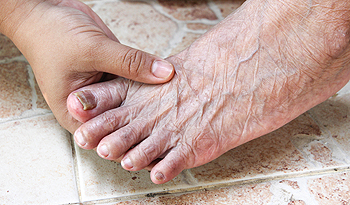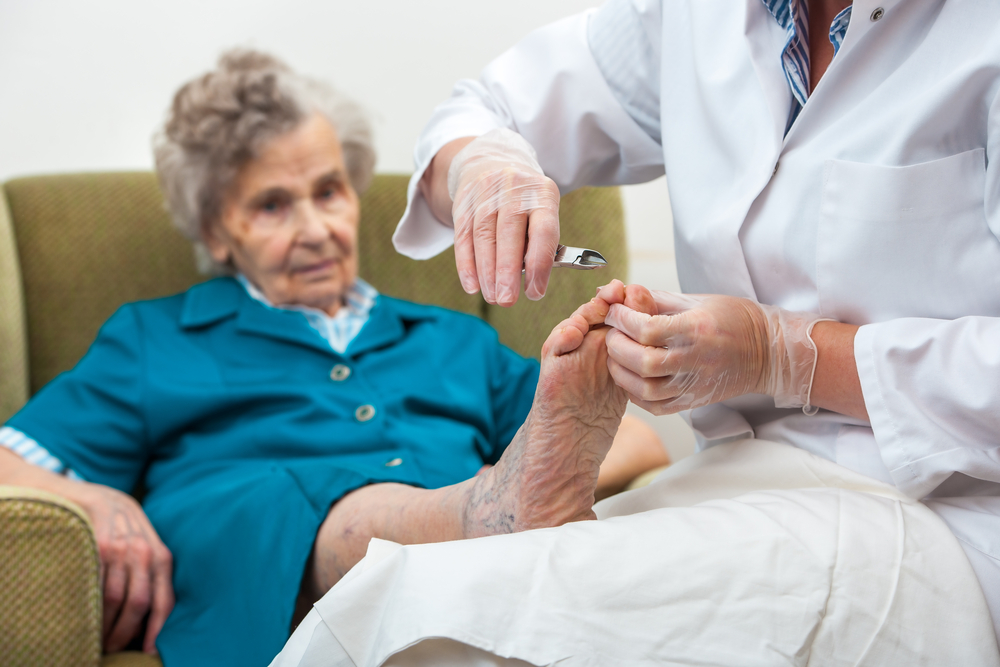
 The condition known as rheumatoid arthritis is a painful ailment that typically affects the muscles and joints. When this occurs in the feet, the toenails may become affected in addition to the patient possibly experiencing pain and stiffness. The discomfort is generally felt in the smaller joints in the feet, and this can possibly lead to the formation of corns and bunions. In severe cases, the toes may curl and hammertoe may develop as a result of this. This particular form of arthritis occurs when the body’s immune system is compromised. The ability to fight infection is diminished, and this may cause pain and swelling to gradually develop. If you are afflicted with rheumatoid arthritis in the joints of the feet, it’s strongly suggested that you consult with a podiatrist, so correct treatment can commence.
The condition known as rheumatoid arthritis is a painful ailment that typically affects the muscles and joints. When this occurs in the feet, the toenails may become affected in addition to the patient possibly experiencing pain and stiffness. The discomfort is generally felt in the smaller joints in the feet, and this can possibly lead to the formation of corns and bunions. In severe cases, the toes may curl and hammertoe may develop as a result of this. This particular form of arthritis occurs when the body’s immune system is compromised. The ability to fight infection is diminished, and this may cause pain and swelling to gradually develop. If you are afflicted with rheumatoid arthritis in the joints of the feet, it’s strongly suggested that you consult with a podiatrist, so correct treatment can commence.
Because RA affects more than just your joints, including the joints in your feet, it is important to seek early diagnosis from your podiatrist if you feel like the pain in your feet might be caused by RA. For more information, contact Dr. Robert Hope of Riverside Podiatry. Our doctor will assist you with all of your podiatric concerns.
What Is Rheumatoid Arthritis?
Rheumatoid Arthritis (RA) is an autoimmune disorder in which the body’s own immune system attacks the membranes surrounding the joints. Inflammation of the lining and eventually the destruction of the joint’s cartilage and bone occur, causing severe pain and immobility.
Rheumatoid Arthritis of the Feet
Although RA usually attacks multiple bones and joints throughout the entire body, almost 90 percent of cases result in pain in the foot or area.
Symptoms
Diagnosis
Quick diagnosis of RA in the feet is important so that the podiatrist can treat the area effectively. Your doctor will ask you about your medical history, occupation, and lifestyle to determine the origin of the condition. Rheumatoid Factor tests help to determine if someone is affected by the disease.
If you have any questions please feel free to contact our office located in Tuscaloosa, and Fayette, AL . We offer the newest diagnostic and treatment technologies for all your foot needs.
Read more about Rheumatoid Arthritis in the Feet A condition that is referred to as onychomycosis is commonly known as a fungal infection of the toenails. It is common among people who have sweaty feet or enjoy spending time swimming. It may occur as a result of the small fungi seeping through tiny cuts in the skin, or possibly lodging between the nail and the nail bed. It may be common to find this type of infection in the toenails because of the warm environment the shoes and socks provide. There are several symptoms associated with this condition, including having a yellow, white or brown appearance, the nail becoming brittle and breaking easily, or the nail becomes uncomfortable. Despite the unsightly appearance, they typically do not pose a health threat unless the patient is diabetic. Research has shown there may be preventative measures that can be taken, including washing and drying the feet, especially between the toes, trimming the nails properly and frequently, and avoiding wearing other people’s shoes. If you feel you have a toenail fungus, it’s suggested to speak with a podiatrist as quickly as possible for a correct diagnosis and to learn about treatment options.
A condition that is referred to as onychomycosis is commonly known as a fungal infection of the toenails. It is common among people who have sweaty feet or enjoy spending time swimming. It may occur as a result of the small fungi seeping through tiny cuts in the skin, or possibly lodging between the nail and the nail bed. It may be common to find this type of infection in the toenails because of the warm environment the shoes and socks provide. There are several symptoms associated with this condition, including having a yellow, white or brown appearance, the nail becoming brittle and breaking easily, or the nail becomes uncomfortable. Despite the unsightly appearance, they typically do not pose a health threat unless the patient is diabetic. Research has shown there may be preventative measures that can be taken, including washing and drying the feet, especially between the toes, trimming the nails properly and frequently, and avoiding wearing other people’s shoes. If you feel you have a toenail fungus, it’s suggested to speak with a podiatrist as quickly as possible for a correct diagnosis and to learn about treatment options.
For more information about treatment, contact Dr. Robert Hope of Riverside Podiatry. Our doctor can provide the care you need to keep you pain-free and on your feet.
Toenail Fungus Treatment
Toenail fungus is a condition that affects many people and can be especially hard to get rid of. Fortunately, there are several methods to go about treating and avoiding it.
Antifungals & Deterrence
Oral antifungal medicine has been shown to be effective in many cases. It is important to consult with a podiatrist to determine the proper regiment for you, or potentially explore other options.
Applying foot powder on the feet and shoes helps keep the feet free of moisture and sweat.
Sandals or open toed shoes – Wearing these will allow air movement and help keep feet dry. They also expose your feet to light, which fungus cannot tolerate. Socks with moisture wicking material also help as well.
If you have any questions please feel free to contact our office located in Tuscaloosa, and Fayette, AL . We offer the newest diagnostic tools and technology to treat your foot needs.
Read more about Treating Toenail Fungus Patients who are diabetic often experience conditions involving the feet. These may include corns, blisters, and foot ulcers, which may typically be a result of elevated blood sugar levels. Many patients experience a tingling sensation and this may prevent cuts, sores, and bruises from being noticed. There are several preventative measures to ensure the feet can feel good. These generally include inspecting the feet daily for any type of cuts or wounds, maintaining dry feet to reduce the possibility of infection, and always wearing shoes or having your feet covered while inside or outside. Additionally, if smoking is part of the patients daily routine, research has shown it is advised to quit, and this may improve circulation in the feet. If you are diabetic, it’s suggested to have your feet checked regularly by a podiatrist who will be able to properly treat any foot conditions related to diabetes.
Patients who are diabetic often experience conditions involving the feet. These may include corns, blisters, and foot ulcers, which may typically be a result of elevated blood sugar levels. Many patients experience a tingling sensation and this may prevent cuts, sores, and bruises from being noticed. There are several preventative measures to ensure the feet can feel good. These generally include inspecting the feet daily for any type of cuts or wounds, maintaining dry feet to reduce the possibility of infection, and always wearing shoes or having your feet covered while inside or outside. Additionally, if smoking is part of the patients daily routine, research has shown it is advised to quit, and this may improve circulation in the feet. If you are diabetic, it’s suggested to have your feet checked regularly by a podiatrist who will be able to properly treat any foot conditions related to diabetes.
Diabetic foot care is important in preventing foot ailments such as ulcers. If you are suffering from diabetes or have any other concerns about your feet, contact Dr. Robert Hope from Riverside Podiatry. Our doctor can provide the care you need to keep you pain-free and on your feet.
Diabetic Foot Care
Diabetes affects millions of people every year. The condition can damage blood vessels in many parts of the body, especially the feet. Because of this, taking care of your feet is essential if you have diabetes, and having a podiatrist help monitor your foot health is highly recommended.
The Importance of Caring for Your Feet
Patients with diabetes should have their doctor monitor their blood levels, as blood sugar levels play such a huge role in diabetic care. Monitoring these levels on a regular basis is highly advised.
It is always best to inform your healthcare professional of any concerns you may have regarding your feet, especially for diabetic patients. Early treatment and routine foot examinations are keys to maintaining proper health, especially because severe complications can arise if proper treatment is not applied.
If you have any questions please feel free to contact our office located in Tuscaloosa, and Fayette, AL . We offer the newest diagnostic and treatment technologies for all your foot needs.
Read more about Diabetic Foot Conditions There is a technique that is referred to as extracorporeal shock wave therapy, which is also known as ESWT, that may aid in treating certain foot conditions such as plantar fasciitis. There are two types of shock wave treatments that may be used, and these are referred to as low-energy and high-energy treatments. Low-energy treatments are typically administered over a period of time and may produce mild discomfort. The opposite may be true of the latter, and is often performed in a single treatment, which may often require general anesthesia. The purpose of these treatments is to promote healing of the tissues and surrounding areas affected by the foot condition. Recent research has shown little effectiveness of these treatments and many patients may still have pain after treatment. It’s important to speak with a podiatrist if you would like additional information about shockwave therapy.
There is a technique that is referred to as extracorporeal shock wave therapy, which is also known as ESWT, that may aid in treating certain foot conditions such as plantar fasciitis. There are two types of shock wave treatments that may be used, and these are referred to as low-energy and high-energy treatments. Low-energy treatments are typically administered over a period of time and may produce mild discomfort. The opposite may be true of the latter, and is often performed in a single treatment, which may often require general anesthesia. The purpose of these treatments is to promote healing of the tissues and surrounding areas affected by the foot condition. Recent research has shown little effectiveness of these treatments and many patients may still have pain after treatment. It’s important to speak with a podiatrist if you would like additional information about shockwave therapy.
Shockwave therapy is a treatment commonly used to treat various injuries and conditions, particularly plantar fasciitis in the feet. To learn more, consult with Dr. Robert Hope from Riverside Podiatry. Our doctor can provide the care you need to keep you pain-free and on your feet.
Shockwave Therapy
Shockwave therapy is a new treatment option designed to treat bone conditions such as tennis elbow, shoulder pain, and others. Shockwave therapy uses high intensity sound waves that are directed to the affected tissues of the body with pinpoint accuracy. The effects are very beneficial, leading to a production of collagen fibers, eliminating inflammation.
Who Benefits from Shockwave?
Shockwave is recommended for patients suffering from heel pain and associated problems. Heel pain is a common condition which can be caused by obesity, overexertion, and spending a substantial amount of time on hard floors with your feet exposed and unsupported.
Fast and Easy
The therapy is actually a simple process that can leave patients feeling better the very next day. Shockwave therapy is not as dramatic as it sounds. It enables more blood flow to effected areas, addressing the source of the problem and allowing treatment to last for a long time.
Treatment & Recovery Time
Shockwave treatment will enable your feet to recover quickly. This is especially important since surgery is not required. It is cost effective and does not require the use of anesthesia. This treatment is a better option to surgery, since it is proven safe.
If you have any questions, please feel free to contact our office located in Tuscaloosa, and Fayette, AL . We offer the newest diagnostic and treatment technologies for all your foot needs.
Read more about Treating Heel Pain with Shockwave Therapy